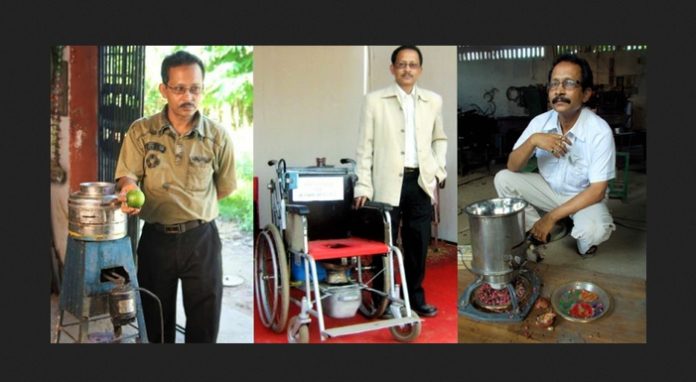
He had to drop out of engineering college in 1987 because he could not afford to pay the fees, and had to care for his family. But that didn’t deter 53-year-old Uddhab Bharali, a poor common man from the north-eastern Indian state of Assam, from inventing 118 devices – including fruit de-seeders, nut peelers, juice extractors, bamboo processors, trench diggers and award winning cement brick making machine, the areca nut peeler, mini-CTC plant for small tea growers, and cassava peeler – to help the poorer sections of the society, rural farmers and small scale industries.
Tea Research Association with Uddhab Bharali invents machine to help small tea growers make their own tea & sell it at their own price
— Eclectic Northeast (@eclectictweets) January 2, 2014
After he was forced to abandon his education, he decided to start a polyethene making business in 1988. But instead of taking a loan of 500,000 INR (about $27,750 at that point) to buy the polythene-making machine, he designed his own machine and sold it for 67,000 INR (about $3720 at that point). Bharali told Rediff.com:
“In 1987, the bank authorities told us that we would have to vacate our home if we did not pay them the money [his family owed the bank a sum of 1.8 million INR]. I was aware that a company was looking for innovators who could design a polythene-making machine. But since the existing product was available for a price of 500,000 INR, I knew that if I wanted the deal, I should try to create a design which would cost less than that.”
Uddhab Bharali from #assam develops feeding machine for the physically handicapped. pic.twitter.com/uuxvjRR4aZ
— North East Blog (@northeastblog) June 13, 2014
Bharali had clearly demonstrated extraordinary talent at a young age, but no one came forward to help him put his intelligence and talent to good use. Things worsened when Bharali lost his elder brother to liver sclerosis in 1995. Since he was now the only earning member in the family, he vowed not only to earn enough to maintain his family, but also help those living below the poverty line.
In 2005, the National Innovation Foundation took notice of Bharali’s talent and hired him as a grassroots innovator. In 2006, his design for a pomegranate de-seeding machine was recognized as the first of its kind not only in India, but across the world. And since then, there has been no looking back for him.
Bharali’s pomegranate de-seeder, which separates the seeds of the pomegranate fruit from the outer skin and the thin inner membrane in a few seconds, won second prize in the “Create the Future Design Contest 2012” organized by the NASA Tech Briefs magazine. The invention has become popular across the United States, Turkey and many European countries. It has a capacity of deseeding 50-55 kg of pomegranate fruits per hour.
Besides being a serial innovator, Bharali is a social entrepreneur. He holds a three-month technical training program for a batch of 10 illiterate students, gives them a stipend of 300-600 INR for the first two months, and by the third month they earn themselves a stipend of 3000 INR through their merit. Bharali has also developed toilet-chairs for the handicapped, and opened an orphanage-cum-old age home.
“Although I started innovating to help poor people live better lives, I realized that by doing so, I was not able to generate enough money for my research and raw materials. I ended up making and distributing products free of cost to people. So I decided to commercialize my designs and make money through royalties, which I would use to meet my research and philanthropic needs. Of the 25% profits I earn through royalties every month, I spend 10% on an old age home, 10% on an orphanage and keep 5% for myself. I have also started a small research and training institute where I pick illiterate students, educate and train them for three months on technology and its applications.”
Bharali is a recipient of the President’s Grassroots Innovation Award 2009, the Shristi Samman Award 2007, and Rashtriya Ekta Samman 2013. He was one of the speakers in TEDxSITM held in 2014.
This Article (Meet the “Serial Innovator” behind over 100 Incredible Inventions) is a free and open source. You have permission to republish this article under a Creative Commons license with attribution to the author and AnonHQ.com.




